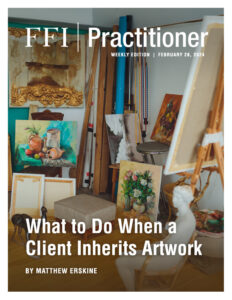
View this edition in our enhanced digital edition format with supporting visual insight and information.
Many enterprising families create unique collections of artwork, which ultimately may be passed from one generation to the next. When this occurs, family enterprise advisors or family office professionals may be asked to help their clients manage these newly acquired assets. In this week’s edition of FFI Practitioner, Matthew Erskine presents three important steps for advisors to help their clients once they’ve inherited an art collection.
As a trusted advisor, it’s important to understand how to best support clients when they inherit artwork. The experience can be both exciting and overwhelming for them, as they hope for a valuable inheritance but fear it may be worthless. Just like Antiques Roadshow, where people turn to appraisers to discover the true worth of their possessions, clients will turn to their advisors for guidance.
When family members inherit artwork or other collectibles, a significant portion of their net worth can become tied up in this unique tangible personal property. According to a recent Barclays Wealth Insight Report,1 these treasure-assets can account for up to ten percent of a client’s wealth in the US and up to twenty percent globally, particularly for mid-tier family clients. One role for a family enterprise advisor can be to help clients strike a balance between their existing investments and legal and financial planning, and the specialized planning required to manage these unique assets.
While an advisor or family office professional may assist with the execution of specific instructions from clients regarding selling, purchasing, or donating items, the responsibilities can go beyond that. An advisor or trusted family office employee may also track the collection on the balance sheet, arrange financing for acquisitions and maintenance, and provide overall support in handling the newly inherited collection.
By providing expertise and guidance, he or she can help alleviate the emotions and uncertainties that come with inheriting artwork, ensuring that clients feel confident and supported throughout the process.
A primary concern for clients often arises from their lack of knowledge regarding the true value of inherited artwork and collectibles. Unlike stocks, bonds, or real estate, determining the value of these items is not readily accessible. Before seeking expert opinions on their worth, it is crucial to assist clients in adjusting to their newfound ownership of artwork. This involves three essential steps: 1) creating an inventory of the collection, 2) streamlining the collection through aggregation, and 3) establishing a foundation for managing the client’s collection. These steps are necessary to prevent underselling rare pieces or investing a significant amount in items with legal ownership or other defects.
Step One: Inventory
Many collectors lack a comprehensive inventory of their assets, and if one exists, it often lacks critical information or is highly cryptic in a format incomprehensible to their heirs. Estate inventories are typically focused on minimizing the estate tax value of assets and are seldom complete or adequately detailed. Additionally, confusion arises when artists work in various media, making it challenging to attribute specific artworks to their creators within the collection. Therefore, expert assistance is necessary to accurately describe assets for the inventory.
Step Two: Aggregate
Even when all significant artwork is properly inventoried, researched, labeled, and stored, clients may be faced with a multitude of items, sometimes numbering into the thousands. These include not only well-known or valuable art, coins, gemstones, jewelry, furniture, and other collectibles, but also the associated masses of documents, catalogs, notes, letters, bills of sale, and paperwork. While it may not seem like much, a single piece of paperwork can be crucial in determining the provenance and value of an item. To support clients and their new collections, each with its own set of taxation, provenance, and valuation issues, it is important to assist them in simplifying these matters.
Taxation: A client’s income from transacting tangible assets is subject to different tax treatment compared to investment or ordinary income. How a client handles ownership of the collection will dictate the subsequent income tax treatment when buying or selling tangible assets. In the US, for instance, the IRS recognizes four distinct types of taxpayers based on their role prior to a transaction: collector, investor, business investor, and dealer. By default, the IRS assumes the client is a collector, imposing the highest capital gains tax and allowing the fewest deductions. However, clients may qualify for the more favorable tax status of an investor. Qualifying as an investor is not as simple as making a declaration; it requires a well-documented pattern of behavior by the client. With the guidance of a qualified expert, they can position themselves to obtain the most advantageous tax status.
Recognition: Aggregating the collection involves considering the stability and volatility of pricing, as well as factors such as questionable legality or uncertainty regarding the client’s legal ownership of items. Establishing the legal title, or provenance, of artwork and collectibles is crucial for clients to either retain ownership or obtain a fair market value when selling. However, the art market is even more unregulated and opaque compared to real estate.
Liquidity: The ease of selling an item is another important aspect of aggregation. Rare or unique items alone may not provide sufficient liquidity; they must also be sought after by those willing to pay for ownership and control. A highly sought-after item can be sold quickly, even if it is poorly executed or damaged, while a flawlessly executed piece by a little-known artist may struggle to find a buyer for months or even years.
Premium: Sometimes, clients may inherit items that they can only dream of owning unless they are prepared to compete with the most affluent collectors and institutions at auction. These premium items exist in a league of their own and require expert assistance in managing preservation, transfer, or sale.
Step Three: Collection Management
A family enterprise advisor or family office professional may have limited or no active involvement in the buying and selling of art and collectibles. However, they may still be asked to play a significant role in supporting clients with effective collection management. To best serve clients in this aspect, it is important to assist them in finding professionals who possess the necessary expertise and experience in managing their collections. Begin by collaborating with clients to address the following considerations for collection management and planning:
- Does the client have a comprehensive understanding of the buy-sell discipline related to their collection?
- Does the client’s personal representative possess the knowledge to effectively maintain and eventually dispose of artwork within their estate?
- Are there insurance policies or estate funds available to alleviate the burden of administrative and tax costs associated with the collection?
- Have the clients kept comprehensive purchase and sale inventory records?
- Has the client specifically addressed in his or her will the disposition of any copyright ownership?
- Are there specific instructions or restrictions regarding the usage or licensing of collection items?
- Has the client made appropriate arrangements for the maintenance and storage of the collection within his or her estate?
- Has the client considered the potential benefits of utilizing split interest trusts and charitable foundations for effective art management?
Conclusion
As the wealth transfer from the Baby Boomer generation continues, it is increasingly possible that family enterprise clients will inherit significant collections of artwork and collectibles. Although the collection may not compare with the financial value of their ownership in a family business, emotionally the possession of artwork can be of very high value. The advisor may play an important role in supporting them as the new owners of these collections. To achieve this, an advisor must help clients acquire the necessary expertise and experience to properly inventory their collections, streamline management through aggregation, and prepare for the eventual transfer of their collections to future generations.
Reference
1 Barclays, Profit or Pleasure? Exploring the Motivations behind Treasure Trends, Barclays Wealth Insights, Volume 15, 2012, www.barclayswealth.com/insights.
–
Disclaimer: This article is general and educational in nature. It is not intended to be, nor should be construed as, legal or tax advice.
About the Contributor

Matthew Erskine is the managing partner of Erskine & Erskine LLC, a fourth-generation law firm, and The Erskine Company, LLC, a consulting firm. He focuses on strategic planning and legal services for business owners, professionals, individuals, families, collectors, and inheritors of unique assets, helping his clients and their families solve their problems through customized estate, tax, and management solutions. Matthew can be reached at m.erskine@erskineco.com.

View this edition in our enhanced digital edition format with supporting visual insight and information.





